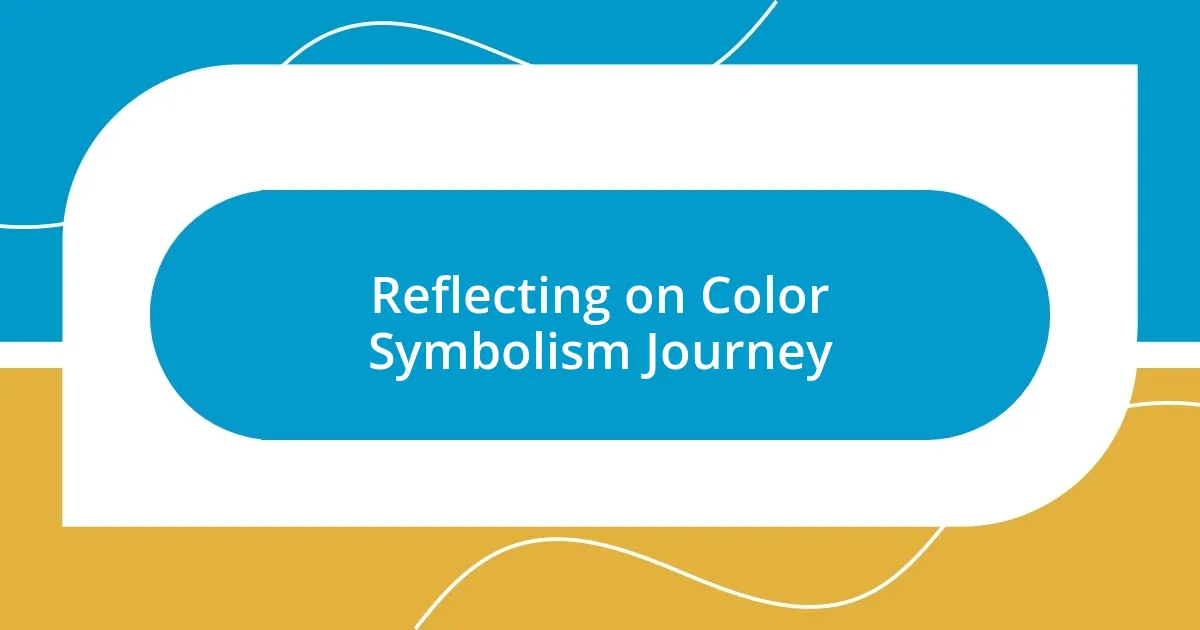Key takeaways:
- Color symbolism evokes emotions and memories, reflecting unique cultural interpretations and personal experiences.
- Historical contexts reveal profound meanings attached to colors, such as gold in ancient Egypt symbolizing the divine and purple denoting power in ancient Rome.
- Methods for understanding color symbolism include qualitative analysis (personal feelings), quantitative analysis (empirical research), and historical context analysis (cultural significance over time).
- Color in art can convey deep emotions, with choices influencing viewer perceptions and personal narratives; exploring colors can enhance artistic expression and connection with audiences.

Understanding Color Symbolism
Color symbolism is a fascinating concept that can evoke deep emotions and memories. For example, I often think of how the color blue reminds me of calm summer days spent by the ocean. It’s amazing how a single hue can transport us back to specific moments in our lives, isn’t it?
When we dive into color symbolism, it’s intriguing to consider how different cultures interpret colors uniquely. I remember attending a wedding where the use of red was profoundly significant, symbolizing joy and prosperity. This personal experience made me wonder: how many other celebrations globally are colored by these rich meanings?
Moreover, the psychological impacts of colors are undeniably powerful. I once painted my office walls a soft green, aiming for tranquility while I worked. It’s interesting to see how the right shade can influence our mood and productivity. Have you ever noticed how certain colors uplift you while others bring you down? It’s worth exploring further!

Historical Context of Color Meaning
Throughout history, colors have held various meanings that reflect cultural beliefs and practices. For instance, I recall researching how ancient Egyptians valued the color gold, associating it with the divine and eternal life. This realization highlighted how deeply intertwined color and culture can be, shaping our understanding of the world around us.
- In ancient Rome, purple signified power and status, primarily reserved for emperors.
- In many Indigenous cultures, red often symbolizes life, vitality, and the earth.
- During the Middle Ages, black came to represent mourning, yet it also suggested formality and sophistication in fashion.
- In Hinduism, saffron represents purity and is often worn during religious ceremonies.
These examples illustrate not just color’s aesthetic value, but its profound emotional and cultural significance throughout history.

Methods for Color Analysis
Understanding color symbolism involves a variety of methods that can enrich our appreciation of colors. One practical approach I’ve found useful is qualitative analysis, where personal feelings and cultural associations shape the interpretation of colors. When I look at the color yellow, for instance, I often recall the warmth of family gatherings. This introspective method reveals how our unique experiences influence our understanding of a hue.
Another effective method is quantitative analysis, which employs data and empirical research to understand color effects. I remember participating in a survey about color preferences and their emotional impacts. It’s fascinating to see how survey data can show that blue consistently scores high for feelings of calmness while red often conveys passion. This combination of personal and statistical insights has deepened my grasp of why certain colors resonate strongly with us.
Finally, historical context analysis offers a window into how colors have been used and interpreted across time. I often refer to color history when creating art, considering how certain shades were associated with specific emotions or cultural meanings in different eras. Reflecting on how my choice of colors echoes historical symbolism always enhances my work, making the exploration of colors not just a personal journey but a shared human experience.
| Method | Description |
|---|---|
| Qualitative Analysis | Personal feelings and cultural associations shape color interpretation. |
| Quantitative Analysis | Data and research reveal emotional responses and preferences related to colors. |
| Historical Context Analysis | Understanding color meanings throughout history enhances personal and artistic choices. |

Personal Experiences with Color
I recall a vivid moment from my childhood when my grandmother handed me a bright red apple. It wasn’t just any apple; to me, it symbolized warmth and love. Holding that apple, I didn’t just see the color red; I felt the passion and energy it radiated. Isn’t it fascinating how a simple color can evoke such strong emotional ties?
As I grew older, I noticed that certain colors greatly impacted my mood. For example, during a particularly stressful week, I painted my workspace a soothing shade of blue. That decision transformed the environment and made me feel significantly calmer and more productive. I can’t help but wonder: how often do we underestimate the power of color in our daily lives?
Recently, I’ve started incorporating more greens into my wardrobe, inspired by nature’s restorative qualities. Each time I wear a green shirt, I’m reminded of those peaceful walks in the park, surrounded by blooming trees. It’s incredible how color not only reflects our inner feelings but also serves as a bridge connecting our personal experiences to the world outside.

Application of Color in Art
Colors in art can express a multitude of emotions and ideas, and I’ve always been fascinated by how even a subtle shift in hue can alter the feeling of a piece. I remember experimenting with a painting where I used a deep blue background, intending to evoke a sense of tranquility. When I stepped back, the image transformed entirely, revealing not just calmness, but also a hint of melancholy. How intriguing is it that one color can carry so many layers of meaning?
In my own artwork, I’ve found that the deliberate choice of vibrant yellows and oranges can create energy and excitement. I once painted a landscape using these hues, and to my delight, viewers commented on how it radiated joy and optimism. Their reactions made me realize the powerful impact color has in inviting viewers to share an emotional space with the artist. Have you ever considered how your color choices affect the story you’re telling?
I’ve often drawn inspiration from the color palettes of famous artists. For instance, studying Van Gogh’s use of contrasting colors sparked a new sense of creativity in me. I began incorporating unexpected color clashes in my work, which not only challenged my perspective but also offered more depth to the narratives I wanted to convey. Isn’t it remarkable how exploring other artists’ approaches can unlock new expressions in our own art?

Exploring Cultural Color Significance
When diving into the realm of color significance across cultures, I often find myself reflecting on the colors that carry profound meaning in different societies. For instance, in many Eastern cultures, white is symbolic of purity and peace, while in the West, it could evoke feelings of sorrow during funerals. I remember attending a wedding where the bride wore a stunning red dress, a celebration of love and prosperity according to her heritage. It made me ponder: how do we perceive colors differently based on our cultural backgrounds?
During my travels, I observed the prominent role color plays in traditional practices. In India, vibrant colors dominate festivals, with each hue conveying specific meanings – like yellow for knowledge and orange for warmth. At a Holi festival, I was enveloped in a rainbow of colors, feeling a sense of unity and joy. This experience truly highlights how color connects communities and embodies shared beliefs and values. Isn’t it amazing how a splash of color can transform an atmosphere and foster a sense of belonging?
I’ve often engaged in discussions about the psychological effects of colors, which can vary significantly across cultures. For example, blue may symbolize trust and tranquility in Western contexts, while in certain African cultures, it can represent death. This realization prompted me to delve deeper into the symbolism behind the colors I chose for my artwork. How can I ensure that my personal interpretation aligns with the cultural narratives around me? Exploring this intricate relationship between color and culture has enriched my own understanding and appreciation of the world around me.

Reflecting on Color Symbolism Journey
As I reflect on my journey through color symbolism, I can’t help but think about the moments that reshaped my perspective. There was a time when I paired a soft green with a bold red, and the result was surprisingly harmonious. It struck me how our preconceived notions of colors can sometimes blur the lines of possibility. Isn’t it fascinating to discover combinations that defy traditional meaning yet resonate deeply?
One experience stands out vividly: while designing a mural for a community project, I chose earthy tones, envisioning a connection to nature. When the locals saw it, I could feel their nostalgia and warmth, emotions tied to their shared experiences with the land. That moment solidified my belief that color not only tells a story; it also weaves threads of connection between people. Have you ever wondered how your choice of color can bridge gaps and foster understanding?
Exploring color symbolism has prompted me to keep a journal filled with thoughts and sketches. Each entry captures my evolving relationship with color, reflecting moments of revelation and surprise. I vividly remember the day I realized how often my feelings mirrored my palette. Whether it was a somber gray during a tough period or a bright pink when experiencing joy, this realization deepened my emotional connection to my work. How about you? Have you noticed your own emotions playing a role in how you see and use color?














